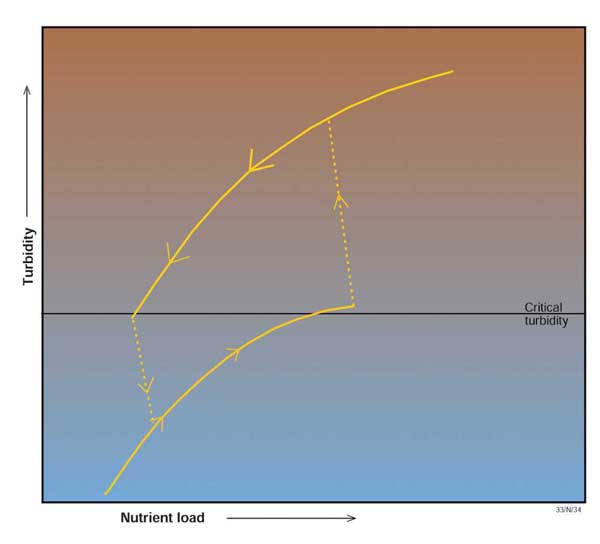Hysteresis
Hysteresis occurs when the response of an estuary, as a driving variable intensifies, is different to the trajectory as the driving variable subsides (Figure 1). An example is the response of the estuary to increasing loads of nutrients from the catchment. At low loads, seagrass dominates the flora, but as loads increase, phytoplankton gradually increase [1,2]. At a critical load, the phytoplankton concentration increases sufficiently that the seagrass do not have enough light to grow. The seagrass population collapses allowing the phytoplankton to grow to even higher concentrations. Even if the load is reduced to below the critical load, the phytoplankton concentrations remain high enough that seagrass do not return. It is only when loads are reduced considerably below the critical load that seagrass growth returns. This is called hysteresis.
Another important cause of hysteresis in estuaries is the termination of nitrification
(hence denitrification) during progressive eutrophication,
giving rise to large internal loads of ammonia
[3].
Such hysteresis effects and ‘alternative stable states’ are also observed in shallow lakes [4-7].

Figure 1. Hysteresis in terms of nutrients and turbidity. Submerged aquatic vegetation (including seagrasses) disappears when turbidity exceeds a critical level, and subsequent changes in turbidity with nutrient concentrations follows a different trajectory (modified after Scheffer 2001 [4].
- Borum, J. and Sand-Jensen, K. 1996. Is total primary production in shallow coastal marine waters stimulated by nutrient loading? Oikos 76, 406-410.
- Murray, A.G. and Parslow, J.S. 1999. Modelling of nutrient impacts in Port Phillip Bay – a semi-enclosed marine Australian ecosystem. Marine and Freshwater Research 50, 597-611.
- Harris, G.P. 1999. Comparison of the biogeochemistry of lakes and estuaries: ecosystem processes, functional groups, hysteresis effects and interactions between macro- and microbiology. Marine and Freshwater Research 50, 791-811.
- Scheffer, M., Hosper, S.H., Meijer, M-L., Moss, B. and Jeppensen, E. 1993. Alternative equilibria in shallow lakes. TREE 8(8), 275-279.
- Scheffer, M. 2001. Alternative attractors of shallow lakes. The Scientific World 1, 254-2634.
- Ogden, R. 2000. Modern and historical variation in aquatic macrophyte cover of billabongs associated with catchment development. Regulated Rivers: Research and Management 16, 497-512.
- Reid M., Fluin J., Ogden R., Tibby J. and Kershaw P. 2002. Long-term perspectives on human impacts on floodplain-river ecosystems, Murray-Darling Basin, Australia. Verhandlungen der Internationalen Vereinigung für Theoretische und Angewandte Limnologie 28(2), 710-716.
Contributors
Ralph Ogden, CSIRO Land and Water
Ian Webster, CSIRO Land and Water


